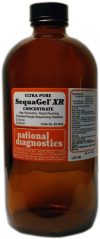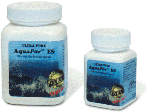Electrophoresis
SequaGel XR Concentrate
$140.50 – $524.00
Catalog number: EC-843
- Extended Range Gel Solution for DNA Electrophoresis
- Higher Resolution
- Rapid Running
- Available as a Premixed 2 Bottle Kit or Concentrate
Description
Catalog number: EC-843
- Extended Range Gel Solution for DNA Electrophoresis
- Higher Resolution
- Rapid Running
- Available as a Premixed 2 Bottle Kit or Concentrate
National Diagnostics’ SequaGel XR is specially formulated to produce greater resolution and more information — up to 500 DNA bands on a single-load gel. SequaGel XR’s optimized, proprietary formulation prevents aberrant band inversions and yields sharp, clear, highly resolved bands.
SequaGel XR runs substantially faster than traditional gels, while actually improving resolution. These results are achieved in a comfortable time-tested format, providing full interlaboratory reproducibility.
By preventing band inversions, SequaGel XR bands are sharp and true. SequaGel XR provides more information by allowing greater separation between bands near the top of the gel. This effect, similar to a wedge gel, is achieved with standard spacers.
The quality and consistency of SequaGel XR is evidenced by the uniform background obtained upon drying. Band edges are sharp. Even without fixing, the gel will dry without cracking or crazing. The result is a finely-rendered, highly detailed DNA gel.
SequaGel XR Concentrate is manufactured as a 50% stock solution. SequaGel XR is also shipped as a two component system consisting of the SequaGel XR Monomer Solution and SequaGel Complete Buffer. SequaGel Complete Buffer Solution contains TBE and TEMED. No dilutions are necessary in this easy to use system. The researcher simply combines the two solutions, adds ammonium persulfate, and casts the gel.
Storage: SequaGel XR Concentrate is stable for one year when stored tightly capped, in a dark area at room temperature (20°C).
Additional information
| Weight | 3 lbs |
|---|---|
| Dimensions | 7 × 7 × 11 in |
Safety Overview
Safety Summary (see SDS for complete information before using product):
Appearance and Odor:
Clear colorless solution
May cause cancer. May cause heritable genetic damage. Also toxic in contact with skin and if swallowed. Danger of serious damage to health by prolonged exposure through inhalation, in contact with skin or if swallowed.
Avoid exposure, obtain special instructions before use. In case of accident or if you feel ill, seek medical advice immediately (show the label where possible).
EMERGENCY OVERVIEW – IMMEDIATE HAZARD
WARNING! ACRYLAMIDE IS A NEUROTOXIN. HARMFUL IF SWALLOWED. MAY CAUSE ALLERGIC SKIN REACTION. MAY CAUSE EYE IRRITATION. HAZARDOUS POLYMERIZATION MAY OCCUR FROM EXCESSIVE HEAT OR CONTAMINATION.
- UV Shadowing
- Using PAGE to Determine Nucleic Acid Molecular Weight
- Uneven Staining
- The Polyacrylamide Matrix-Buffer Strength
- The Polyacrylamide Matrix
- The Mechanical and Electrical Dynamics of Gel Electrophoresis — Electrophoresis System Dynamics
- The Mechanical and Electrical Dynamics of Gel Electrophoresis – Ohm’s Law
- The Mechanical and Electrical Dynamics of Gel Electrophoresis – Intro and Sample Mobility
- The Electrophoresis Matrix
- The Agarose Matrix
- Staining Proteins Immobilized on Membranes
- Staining Protein Gels with Coomassie Blue
- SSCP Analysis
- Southern Blotting
- Smeared Bands
- Silver Staining Protein Gels
- Silver Staining DNA Gels
- Sanger Sequencing
- Sample Preparation for SDS-PAGE
- Sample Preparation for Native Protein Electrophoresis
- Sample Preparation for Native PAGE of DNA
- Sample Prep for Denaturing PAGE of DNA
- S1 Mapping
- Run Conditions in Denaturing PAGE
- RNA Mapping
- RNA Electrophoresis
- Ribonuclease Protection
- Restriction Digest Mapping
- Radioactive Emissions and the Use of Isotopes in Research
- Protein Fixation on Gels
- Primer Extension
- Preparing Denaturing DNA & RNA Gels
- Preparation of Denaturing Agarose Gels
- Preparation of Agarose Gels
- Pouring Sequencing Gels
- Post-Electrophoretic Visualization with Nuclistain
- PFGE and FIGE
- Peptide Mapping
- PCR Analysis: Yield and Kinetics
- PCR Analysis: An Examination
- Overview of Western Blotting
- Northern Blotting
- Native Protein Electrophoresis
- Native PAGE of DNA
- Multiphasic Buffer Systems
- Mobility Shift Assay
- Methylation & Uracil Interference Assays
- Method for Western Blotting
- Mechanism of Immunostaining
- Mechanism of Immunostaining
- Measuring Molecular Weight with SDS-PAGE
- Maxam & Gilbert Sequencing
- Manual Sequencing
- Isotachophoresis
- Isoelectric Focusing
- In Gel Enzyme Reactions
- Immunostaining with Alkaline Phosphatase
- Immuno-Electrophoresis / Immuno-Diffusion
- Horizontal and Vertical Gel Systems – Vertical Tube Gels
- Horizontal and Vertical Gel Systems – The Vertical Slab Gel System
- Horizontal and Vertical Gel Systems – The Horizontal Gel System
- Homogeneous Buffer Systems
- Heteroduplex Analysis
- Guide Strip Technique
- Gel Preparation for Native Protein Electrophoresis
- Gel Preparation for Native PAGE of DNA
- Gel Electrophoresis of RNA & Post Electrophoretic Analysis
- Gel Electrophoresis of PCR Products
- Faint bands, low background
- Faint Bands, High Background
- Ethidium Bromide Staining
- Enzyme Linked Immunosorbent Assay (ELISA)
- Electrophoresis Buffers-Choosing the Right Buffer
- Electrophoresis Buffers–The Henderson-Hasselbalch Equation
- DNase I Footprinting
- DNA/RNA Purification from PAGE Gels
- DNA/RNA Purification from Agarose Gels – Electroelution
- Differential Display
- Denaturing Protein Electrophoresis: SDS-PAGE
- Denaturing Polyacrylamide Gel Electrophoresis of DNA & RNA
- Coomassie Blue Stain- Troubleshooting
- Conformational Analysis
- Casting Gradient Gels
- Buffer Additives-Surfactants
- Buffer Additives-Reducing Agents
- Buffer Additives-Hydrogen Bonding Agents
- Blotches on Gel
- Biological Macromolecules: Nucleic Acids
- Biological Macromolecules – Proteins
- Autoradiography
- Autoradiographic Enhancement with Autofluor
- Automated Sequencers
- Analysis of DNA/Protein Interactions
- An Overview of Northern and Southern Blotting
- Alkaline Blotting
- Agarose Gel Electrophoresis of DNA and RNA – Uses and Variations
- Agarose Gel Electrophoresis of DNA and RNA – An Introduction
- Activity Stains




